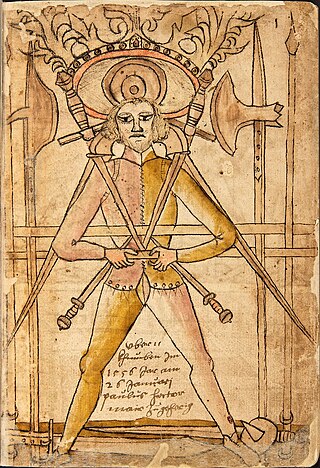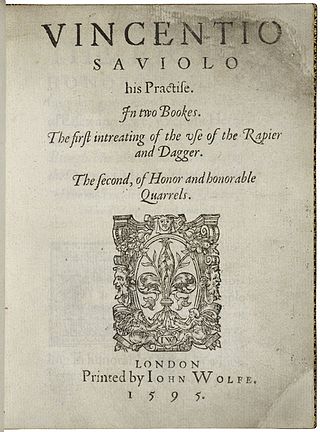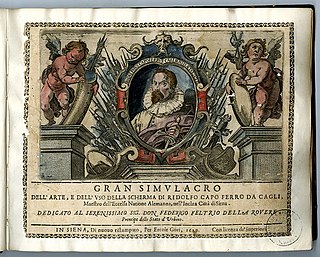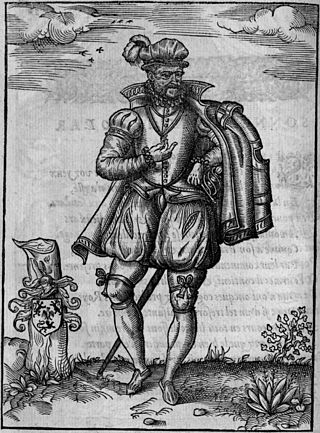Related Research Articles

A rapier or espada ropera is a type of sword with a slender and sharply pointed two-edged blade that was popular in Western Europe, both for civilian use and as a military side arm, throughout the 16th and 17th centuries.

Stage combat, fight craft or fight choreography is a specialised technique in theatre designed to create the illusion of physical combat without causing harm to the performers. It is employed in live stage plays as well as operatic and ballet productions. With the advent of cinema and television the term has widened to also include the choreography of filmed fighting sequences, as opposed to the earlier live performances on stage. It is closely related to the practice of stunts and is a common field of study for actors. Actors famous for their stage fighting skills frequently have backgrounds in dance, gymnastics or martial arts training.
Maestro Ramón Martínez is an American master of classical and historical fencing. He studied classical fencing with the late Maître d'Armes Frederick Rohdes in New York City for ten years. Maître Rohdes was one of the last fencing masters to teach fencing as a martial art, himself having learned a variety of historical fencing systems from his own master, Maître d'Armes Marcel Cabijos. During that time Mr. Martínez became assistant and protégé of Maître Rohdes and was the only one of his pupils permitted to teach with full authorization at the Rohdes Academy.
George Silver was a gentleman of England during the late 16th and early 17th centuries, who is known for his writings on swordplay. He is thought to have been the eldest of four brothers, and eleventh in descent from Sir Bartholomew Silver, who was knighted by Edward II. He married a woman named Mary Haydon in London, in 1580. Silver's activities after the publication of his book are unclear. The fencing historian Aylward claims that he was alive in 1622, when he was visited by Cooke, Clarenceux King-of-Arms. However, Robert Cooke died in 1593. The Clarenceux King-of Arms in 1622 was William Camden, but as he became paralyzed in 1622 and died in 1623 it is doubtful whether he visited Silver either.

Historical European martial arts (HEMA) are martial arts of European origin, particularly using arts formerly practised, but having since died out or evolved into very different forms.
Martial arts manuals are instructions, with or without illustrations, specifically designed to be learnt from a book. Many books detailing specific techniques of martial arts are often erroneously called manuals but were written as treatises.

The German school of fencing is a system of combat taught in the Holy Roman Empire during the Late Medieval, German Renaissance, and Early Modern periods. It is described in the contemporary Fechtbücher written at the time. The geographical center of this tradition was in what is now Southern Germany including Augsburg, Frankfurt, and Nuremberg. During the period in which it was taught, it was known as the Kunst des Fechtens, or the "Art of Fighting". The German school of fencing focuses primarily on the use of the two-handed longsword; it also describes the use of many other weapons, including polearms, medieval daggers, messers, and the staff, as well as describing mounted combat and unarmed grappling (ringen).
Anthony Charles De Longis is an American actor, stuntman, and fight choreographer.

The term Italian school of swordsmanship is used to describe the Italian style of fencing and edged-weapon combat from the time of the first extant Italian swordsmanship treatise (1409) to the days of Classical Fencing.

Francesco Ferdinando Alfieri was a master of fencing of the 17th century. He was a representative of the Venetian school of fencing and “Maestro D’Arme” to the Accademia Delia in Padua in 1640. Alfieri was originally from Padua, which at that time was considered territory of the Venetian Republic.
Rapier Combat is a style of historical fencing practiced in the Society for Creative Anachronism (SCA). The primary focus is to study, replicate and compete with styles of rapier sword-fighting found in Europe during the Renaissance period, using blunted steel swords and a variety of off-hand defensive items. Participants wear period clothing while competing, along with or incorporating protective equipment for safety. In the April 2020 update of the rules, the sport was renamed 'Fencing Combat'.

Fencing master Vincentio Saviolo, though Italian born and raised, authored one of the first books on fencing to be available in the English language.

Salvator Fabris (1544-1618) was an Italian fencing master from Padua. During his life he taught in various European countries, most notably in Denmark where he was the fencing instructor of King Christian IV. It was during his time in Copenhagen that he published his treatise on rapier fencing, Lo Schermo, overo Scienza d’Arme, in 1606. The treatise became a fencing bestseller around Europe, and was reprinted until 1713 and translated into several languages, notably into German, and again in 2005, into English.

Ridolfo Capo Ferro da Cagli was an Italian fencing master in the city of Siena, best known for his rapier fencing treatise published in 1610.

The known history of fencing in France begins in the 16th century, with the adoption of Italian styles of fencing.
In fencing, forte is "the strong part" of the blade—the one-third closest to the hilt. The "strength" refers to the control established over the opponent's weapon upon contact of one's forte with the opponent's foible.
The oldest surviving manual on western swordsmanship dates back to the 14th century, although historical references date fencing schools back to the 12th century.
The Chicago Swordplay Guild is a modern school of swordsmanship and Western martial arts, and non-profit organization based in Chicago, Illinois, United States. It provides organized instruction in the study and practice of historical European swordplay, with a principal focus on the Italian school of swordsmanship and other martial arts of the 14th–17th centuries. Co-founded in 1999 by Gregory Mele and Mark Rector, the Chicago Swordplay Guild seeks to be consistent with the methodology of the ancient European fencing schools by combining scholarship and research into the teachings of the historical Masters, with the practical knowledge gained through solo and partnered drilling and fencing. Since techniques are taught in reference to how effective they would be in a real encounter, the Guild practices with an absolute emphasis on safety, control, competence, and skill at arms.
Italian martial arts include all those unarmed and armed fighting arts popular in Italy between the Bronze age until the 19th century AD. It involved the usage of weapons. Each weapon is the product of a specific historical era. The swords used in Italian martial arts range from the Bronze daggers of the Nuragic times to the gladius of the Roman legionaries to swords which were developed during the renaissance, the baroque era and later. Short blades range from medieval daggers to the liccasapuni Sicilian duelling knife.
The practice of Historical European Martial Arts (HEMA) first started in Australia in the late 19th century before largely dying out. There was then a revival of interest in the late 20th century to the current day. The practice of HEMA in Australia has grown to be a popular activity, with clubs all in capital cities, and the larger cities in Australia, Sydney and Melbourne, each have a number of clubs teaching various styles.
References
- ↑ "Instructors: Martinez Academy of Arms". Martinez-destreza.com. Retrieved 2012-09-05.
- ↑ "Art of Combat Fight Director Page". Artofcombat.org. Retrieved 2012-09-05.
- ↑ faculty. "Jared Kirby at SUNY Purchase". purchasecollegeathletics.com. Retrieved 2012-09-05.
- ↑ "Leonia Rec Dept Classes". Jared Kirby. Retrieved 2012-09-05.
- ↑ "Combat for Stage & Screen classes by Jared Kirby in New York City". Artofcombat.org. Retrieved 2012-09-05.
- ↑ "The Paddy Crean Stage Combat Conference". Paddycrean.com. Retrieved 2012-09-05.
- ↑ "CombatCon". Combat Con. Retrieved 2012-09-05.
- ↑ "NYCSS Summer Intensive".
- ↑ "International Swordfighting and Martial Arts Convention". Theismac.org. Retrieved 2012-09-05.
- Kirby, Jared (2004). Italian Rapier Combat - Ridolfo Capo Ferro . Greenhill Books, London. ISBN 1853675806.
- Kirby, Jared (2005). Domenico Angelo, The School of Fencing: With a General Explanation of the Principal Attitudes and Positions Peculiar to the Art. Greenhill Books. ISBN 978-1853676260.
- Kirby, Jared (2014). A Gentleman's Guide to Duelling: Of Honour and Honourable Quarrels - Vincentio Saviolo . Frontline Books. ISBN 978-1848325272.
- Kirby, Jared (2017). THE Expert Sword-Man's Companion: Or the True Art of SELF-DEFENCE. WITH An ACCOUNT of the Authors LIFE, and his Transactions during the Wars with France.: To which is Annexed, The ART of GUNNERIE. CreateSpace Independent Publishing Platform. ISBN 1542618320.
- Kirby, Jared (2021). Staging Shakespeare's Violence. Pen and Sword History. ISBN 1526762404.
- Kirby, Jared (2021). Italian Rapier Combat 2nd Edition- Ridolfo Capo Ferro . Greenhill Books, London. ISBN 178438691X.